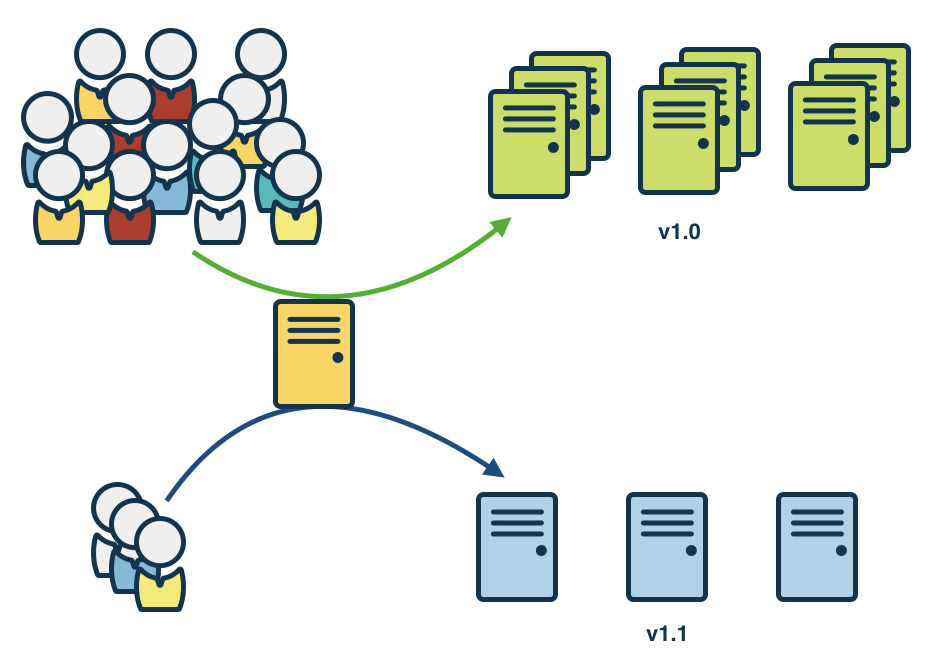Understanding Canary Releases in Modern Software Development

A canary release is a phased approach to introducing new features to a small group of users before making them available to everyone. This method helps you test updates in real-world conditions while reducing the risk of widespread issues. By observing how users interact with the changes, you can gather valuable feedback and ensure the software performs as expected.
Many companies rely on this strategy to maintain stability. For example:
Company | Description |
|---|---|
Netflix | Uses canary deployments to gradually roll out new features to a small percentage of users. |
Amazon | Employs canary deployments to ensure new updates are tested before full deployment. |
Financial Services | Banks use canary deployments to test critical updates in a controlled environment. |
Canary release software enables you to deliver features safely and efficiently, ensuring a seamless experience for your users.
Key Takeaways
A canary release lets you test new features with fewer users. This lowers the chance of big problems and collects helpful feedback.
Feature flags are important for canary releases. They help you decide which features users can see and allow quick fixes if something goes wrong.
Watching performance data during a canary release is very important. Check CPU use, errors, and user activity to find problems early.
Canary releases work well for risky features and important updates. They keep things stable and make features better using real user feedback.
What is a Canary Release?

Definition and Key Characteristics
A canary release is a strategy where you introduce new features to an initial subset of users before rolling them out to everyone. This approach allows you to test updates in real-world conditions while minimizing risks. Unlike traditional deployment methods, canary releases focus on gradual rollouts, enabling you to gather feedback and monitor performance effectively.
Key characteristics of a canary release include:
Gradual release of changes in production for rigorous testing.
Real-world testing with a small subset of users to detect issues early.
Faster and cheaper rollback compared to other deployment strategies.
This method contrasts with blue-green deployments, which rely on two separate production environments. While blue-green deployments ensure thorough testing, they can be resource-intensive and complex. Canary releases, on the other hand, balance speed and safety, making them ideal for dynamic software environments.
Difference Between Canary Release and Canary Deployment
Although the terms "canary release" and "canary deployment" are often used interchangeably, they refer to different stages of the software delivery process. A canary deployment focuses on deploying new code to production, while a canary release emphasizes the controlled exposure of features to users.
In modern software development, deployments often include multiple features. With a canary release, you can use feature flags to control which features are visible to users. This separation of deployment and release ensures that even if one feature encounters issues, you can isolate it without affecting others.
Importance of Feature Flags in Canary Releases
Feature flags play a crucial role in the success of a canary release. They allow you to enable or disable features at runtime, providing enhanced control and flexibility. By using feature flags, you can:
Gradually roll out features to a small subset of users, minimizing risks.
Monitor performance and collect feedback during the release process.
Isolate problematic features without impacting the entire application.
For example, if a feature causes unexpected issues, you can quickly disable it using a feature flag. This approach eliminates the need for redeployment, saving time and reducing complexity. Feature flags also support business-critical updates by ensuring stability and protecting revenue streams.
How Does a Canary Release Work?
Step-by-Step Process
Deploying features with feature flags
Feature flags are essential for executing a canary release. They allow you to control which features are visible to users after deployment. First, you deploy all features to production but keep them hidden behind feature flags. This setup ensures that you can activate or deactivate individual features without redeploying the entire application. Feature flags also simplify testing by enabling you to isolate specific features for evaluation.
Releasing features to a small subset of users
The next step involves selecting a small, representative group of users as your "canary group." This group experiences the new features first. You can use programmable load balancers to route traffic from this subset to the updated version. This controlled exposure helps you identify potential issues in a real-world environment without affecting the majority of users.
Gradually expanding the release
If the canary group reports no significant issues, you can begin a gradual rollout to a larger audience. Automating traffic shaping allows you to increase the number of users accessing the new features incrementally. This approach minimizes risks and ensures that any problems can be addressed before a full rollout.
Monitoring and Observing Metrics
Key metrics to track
Monitoring is critical during a canary release. Focus on metrics like CPU usage, memory footprint, and HTTP return codes to assess system performance. Track error rates to identify bugs early. Measure latency to ensure quick response times. Additionally, monitor user engagement to understand how users interact with the new features.
Tools for monitoring Canary Releases
Several tools can help you monitor metrics effectively. Prometheus tracks performance and generates alerts for anomalies. Grafana visualizes data through customizable dashboards. Datadog monitors logs, metrics, and traces in real time. Amazon CloudWatch and New Relic provide detailed insights into performance changes, helping you make informed decisions during the release process.
Rollback Strategies
Using feature flags for rollbacks
Feature flags enable a quick rollback by allowing you to deactivate problematic features instantly. This method eliminates the need to revert the entire deployment, saving time and reducing complexity. For example, if a feature causes unexpected errors, you can disable it with a single action, ensuring stability for your users.
Best practices for minimizing impact
A robust rollback plan is essential for minimizing user impact. Automate rollback mechanisms to quickly revert changes if issues arise. Maintain proper backups to ensure data consistency. Plan for schema changes to manage database transitions effectively. These practices ensure that you can address problems swiftly while maintaining a seamless user experience.
Benefits and Challenges of Canary Releases

Benefits
Reduced risk of widespread issues
A canary release minimizes the impact of bugs by limiting exposure to a small group of users. This controlled approach allows you to identify and address defects early, reducing the likelihood of widespread disruptions. Companies like Facebook and Google rely on this method to ensure safer software rollouts. By testing changes in real-world conditions, you can mitigate risks and maintain system stability.
Faster feedback from real users
Real-world feedback is invaluable during software development. Canary releases let you gather insights from actual users interacting with your updates. This feedback helps you refine features before a full rollout. Early detection of issues also speeds up the development cycle, enabling you to deliver updates more efficiently.
Improved user experience and stability
Gradual updates ensure a smoother experience for your users. By refining features based on feedback from a small group, you can deliver a polished product to a broader audience. Controlled rollouts prevent disruptive changes, ensuring stable and reliable updates. Additionally, rollback mechanisms allow you to quickly revert problematic changes, maintaining overall system stability.
Challenges
Complexity in implementation
Implementing a canary release requires careful planning and technical expertise. You must maintain multiple software versions and manage database schema changes effectively. Automation tools can simplify this process, but they require upfront investment and setup.
Dependency on robust monitoring tools
Continuous monitoring is essential for tracking performance and identifying issues during a canary release. Without robust tools, you may miss critical errors or performance drops. Tools like Prometheus and Datadog can help, but they add to the resource requirements.
Potential user segmentation issues
Selecting the right user group for testing is crucial. Poor segmentation can lead to skewed feedback or negative user experiences. For example, financial applications require extra caution to avoid disrupting sensitive operations. Careful planning and clear criteria for user selection can mitigate these risks.
When to Use and Avoid Canary Releases
Ideal Scenarios
High-risk feature rollouts
You should consider a canary release when deploying high-risk features. This approach allows you to test updates in a real-world environment without exposing your entire user base to potential issues. By directing only a small group of users to the new version, you can identify early warnings and address them promptly. This method balances speed and safety, making it ideal for features that could significantly impact your application’s functionality.
Business-critical updates
For business-critical updates, a canary release minimizes the risk of large-scale disruptions. Releasing updates to a small subset of users first helps uncover compatibility issues that may not appear in pre-production environments. This controlled rollout ensures a smoother user experience and allows you to refine the update based on feedback from the canary group. Faster identification of bugs or performance issues improves the overall quality of your software.
Large-scale user bases
If your application serves a large user base, a canary release provides a structured way to manage updates. You can monitor performance metrics for both the canary group and the broader audience using robust tools. Automated rollback mechanisms help minimize disruptions if issues arise. Additionally, gathering user feedback during the canary phase ensures the success of the deployment.
When to Avoid
Low-impact or internal-only changes
Avoid using a canary release for low-impact or internal-only changes. The time and effort required for manual canary releasing may outweigh the benefits. If the system or application lacks proper monitoring and instrumentation, the value of a canary release diminishes.
Lack of monitoring infrastructure
Without robust monitoring tools, you may struggle to track performance or detect issues during a canary release. Applications with incompatible backend changes or complex database rollbacks also pose challenges. These scenarios require careful planning to ensure version coexistence and data consistency.
Tight deadlines with no room for gradual rollout
Canary releases are unsuitable when deadlines demand immediate updates. Gradual rollouts require time to monitor metrics, gather feedback, and address issues. In such cases, a direct deployment strategy may be more practical.
How to Implement a Canary Release Effectively
Setting Up Feature Flags
Feature flags are essential for a successful canary release. They allow you to control feature availability dynamically, enabling you to activate or deactivate features without redeploying the application. To set up feature flags effectively, follow these steps:
Gradual Rollout: Start by releasing the feature to a small group of users, such as internal testers or beta users. Gradually increase exposure to monitor performance and gather feedback.
Feature Flag Configuration: Configure feature flags to manage feature visibility. This setup ensures flexibility and reduces the risk of widespread issues.
Monitoring and Feedback: Continuously track performance metrics and collect user feedback. Use this data to make informed decisions about expanding the rollout.
Automated Rollback: Implement rollback mechanisms to quickly disable problematic features. This approach ensures system stability and minimizes downtime.
By following these steps, you can manage feature rollouts with precision and reduce risks during the deployment process.
Choosing the Right User Segments
Selecting the right user segments is crucial for a successful canary release. A well-chosen group ensures accurate feedback and minimizes disruptions. Consider the following strategies:
Choose a diverse subset of users to represent your overall user base.
Include users from different regions, devices, and network conditions.
Target early adopters who are more likely to provide detailed feedback.
Start with an internal rollout to employees before expanding to external users.
Allow users to self-select for participation, especially for beta testing programs.
For most cases, including 5-10% of your user base in the initial rollout provides a balanced approach. This strategy ensures that the feedback you receive is both reliable and actionable.
Establishing Monitoring and Alerting Systems
A robust monitoring and alerting system is vital for tracking performance during a canary release. These systems help you identify issues early and respond quickly. Key components of an effective monitoring setup include:
Component | Description |
|---|---|
Monitor system performance for both the canary group and the broader audience. | |
Real-Time Data Analysis | Detect anomalies and patterns promptly to prevent issues from escalating. |
Automated Rollback Mechanisms | Revert changes automatically if critical issues arise during deployment. |
Monitoring and logging systems are indispensable for a successful canary release. They track key metrics like error rates, response times, and resource usage.
Tools like Prometheus, Grafana, and Datadog provide real-time insights and customizable dashboards. These tools allow you to monitor metrics such as CPU usage, error rates, and user engagement. By establishing a strong monitoring system, you can ensure a smooth rollout and maintain zero downtime during the process.
Planning for Rollbacks and Contingencies
Planning for rollbacks is essential to ensure a smooth and stable canary release. Even with thorough testing, unexpected issues can arise during a rollout. A well-prepared rollback strategy minimizes disruptions and protects the user experience.
Start by automating rollback mechanisms. Automation allows you to quickly redirect traffic back to the previous stable version if problems occur. This approach ensures minimal downtime and reduces the risk of prolonged errors affecting users. Additionally, always maintain the ability to revert the entire deployment if necessary. This fallback option provides an extra layer of security when critical issues emerge.
You should also establish a detailed rollback plan. This plan should outline the steps required to revert changes efficiently. Include automated rollback tools to execute these steps swiftly. Proper backups are another critical component. Backups safeguard data integrity and allow you to restore the system to its original state if needed. Furthermore, consider data consistency across different versions. A clear strategy for managing database changes ensures that no data is lost or corrupted during the rollback process.
Tip: Test your rollback procedures regularly in a staging environment. This practice helps you identify potential gaps in your plan and ensures that your team is prepared to act quickly during a real incident.
By prioritizing these contingency measures, you can handle unexpected challenges effectively. A robust rollback strategy not only protects your users but also reinforces the reliability of your canary release process.
A canary release offers a structured way to introduce new features while minimizing risks. It reduces the impact of potential issues by limiting exposure to a small user group. You gain valuable real-world feedback from actual users, which helps refine updates before a full rollout. This approach also supports faster updates and continuous delivery, ensuring minimal downtime.
Feature flags and monitoring systems are essential for success. Feature flags allow you to control feature availability dynamically, while monitoring tools help track performance and detect issues early. By adopting canary releases, you can deliver safer and more efficient software updates, enhancing user satisfaction and system stability.
FAQ
What is the difference between a canary release and a feature flag?
A canary release is a strategy for gradually rolling out features to users. A feature flag is a tool that lets you control feature visibility. You use feature flags to manage canary releases by enabling or disabling features without redeploying the application.
How do you select users for a canary release?
Choose a small, diverse group of users that represents your audience. Include different regions, devices, and network conditions. Start with internal testers or beta users. This ensures accurate feedback and minimizes risks during the rollout.
Can you use canary releases for mobile apps?
Yes, you can. Use feature flags to control feature visibility in mobile apps. Gradually release updates through app stores or beta testing programs. Monitor user feedback and performance metrics to ensure a smooth rollout.
What happens if a canary release fails?
If a canary release fails, use feature flags to disable the problematic feature instantly. This avoids the need for redeployment. Plan for rollbacks and maintain backups to ensure data consistency and system stability.
Are canary releases suitable for all types of updates?
No, they are not. Avoid using canary releases for low-impact or internal-only changes. They are best for high-risk features, business-critical updates, or applications with large user bases. Proper monitoring infrastructure is essential for success.
See Also
Understanding the Canary Release Process and Its Functionality
Exploring the Canary Release Pattern and Its Mechanism
Defining a Canary Launch in Software Deployment Practices
Effective Steps for Implementing a Canary Deployment Model
Understanding Release Toggles and Their Importance in Development

